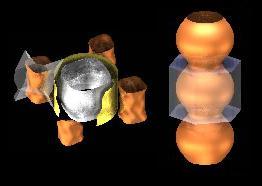 One of the most interesting aspects of modern condensed matter physics is the study of macroscopic manifestations of electron-electron correlations. Such correlations are generally strongest in nearly localised, "narrow band" systems where the Coulomb repulsion energy acquires a similar magnitude to the electronic bandwidth. Examples of such materials are the transition metal oxides, or the heavy fermion materials.
One of the most interesting aspects of modern condensed matter physics is the study of macroscopic manifestations of electron-electron correlations. Such correlations are generally strongest in nearly localised, "narrow band" systems where the Coulomb repulsion energy acquires a similar magnitude to the electronic bandwidth. Examples of such materials are the transition metal oxides, or the heavy fermion materials.
One way to gain insight into how these strong correlations affect the properties of these materials is to study quantum oscillations that arise in metallic samples in strong applied magnetic fields. Due to the wave nature of the electrons, the motion of electrons in a field leads to subtle interference effects which we can pick up, but only at the lowest temperatures, in very strong fields, and only for samples of very high purity. For this purpose, we have a dedicated cryomagnetic system, with fields up to 18 T and temperatures down to a few mK, and with a noise level that is amongst the lowest in the world.
The exact form of the oscillatory interference pattern, and its dependence on field and temperature, gives us both the shape of the Fermi surface and the effective quasiparticle masses. An example of the Fermi surface of the complex oxide material Sr2RuO4 measured in the laboratory is shown in the figure. Quite often, these results are completely surprising and strongly deviate from theoretical predictions. For example, our recent study of the superconducting layered oxide Ag5Pb2O6revealed a Fermi surface totally at odds with theoretical predictions. In fact, thanks to experimental results, this compound has been identified as the first ever (monovalent) nearly free electron superconductor.
Studies in heavy fermion materials, on the other hand, can yield effective mass values 100-1000x higher than electron masses in vacuum that cannot be inferred from first principles. The information so obtained forms an "identity card" for the metallic state on which theories of superconductivity and other Fermi liquid instabilities can be based.
